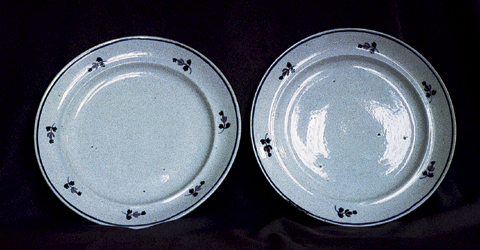
 |
| Figure 7 Plates, Frost & Vodrey, 1832–1839. Cream-colored whiteware. D. 9 1/4" and 9 1/16". (Courtesy, East Liverpool Museum of Art; photo, East Liverpool Camera Mart.) Long before the recent excavation, one of these plates was published in 1939 as made by Vodrey & Frost in Louisville, but no reason was given for the attribution. Findings at the Lewis Pottery site have elevated that attribution to a strong probability. Thinly potted “queensware” plates were indeed found there—although not of this plain, round form. Bits of underglaze-painted decoration were found, although in different colors. And edge lining in brown and black was everywhere, on rims of virtually every kind of vessel. Further, Vodrey’s accounts have many references to “painted” pipes and pitchers, and the word “painted” specifically meant “underglaze decoration.” Interestingly, the flat bottoms without a foot ring, as well as the decorative edge lining, are reminiscent of Wedgwood’s queensware plates, a style with origins in the eighteenth century. Flatware making was a specialized skill and few American potteries ventured into its production. A bat of clay was rolled out to the desired thickness and was pressed face down into a mold that gave shape to what would be the upper surface; the reverse side was shaped by a profile tool held against the revolving clay by a knob or handle as the plate, in its mold, was turned on the wheel. In due time, the hand-held tool evolved into a shaped arm or lever that could be pulled down over the plate; this method was known as jiggering. The visible turning lines on the backs of these two plates might have been made by either method, but Vodrey gave no description of his process. |
| |